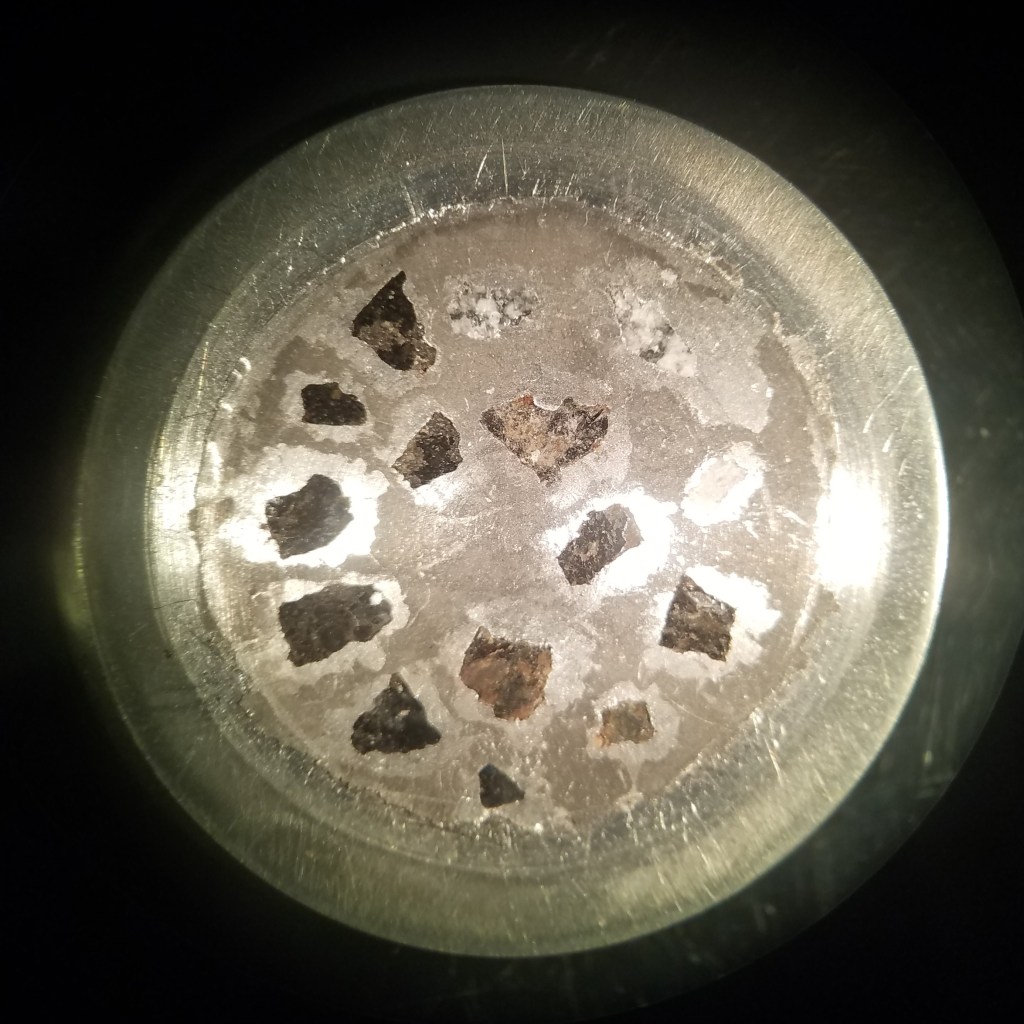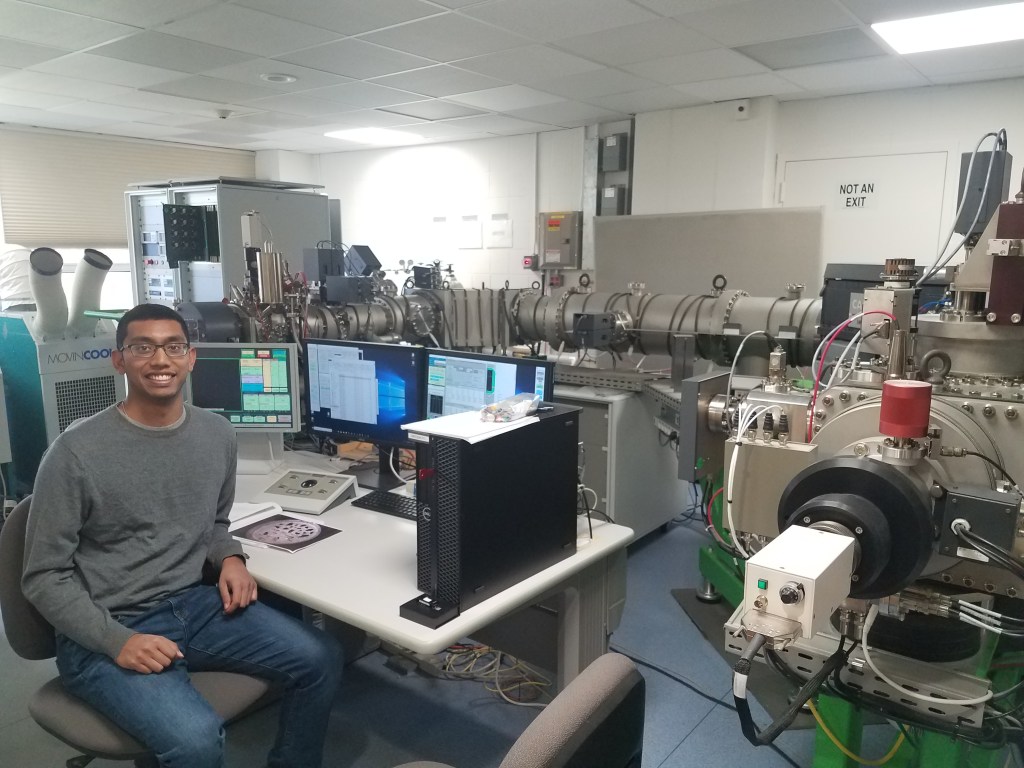By Brendan Anzures, Ph.D. Candidate and NASA Earth and Space Sciences Fellow
I have always been much more impressed by the natural world than by anything envisioned by the human mind. The beauty and complexity of nature seems to stand out, a deep and wondrous gallery not limited by our own thoughts or imaginations. Rocks and minerals especially interest me because, for the most part, they last; all living organisms are magnificent in their time, but they fade quickly. It seems almost otherworldly that many geologic landscapes and individual minerals formed over tens of thousands to millions of years, when we live maybe a hundred years and the oldest trees, a few thousand. Geologic attractions such as the Grand Canyon, the hot springs at Yellowstone, and the volcanoes of Hawaii – three places I had the privilege of seeing when I was young – inspire awe among everyone who visits. But as much as I was fascinated by rocks and minerals and their longevity growing up, I could never really grasp how and why they form the way they do.
I got the chance to learn answers to those questions when I became an undergraduate research assistant early on at Rensselaer Polytechnic Institute working with experimental geochemist and mineral physicist Dr. Heather Watson. Together, we investigated the formation of metal cores in planetesimals, objects in our solar system around 100 kilometers in diameter. I was (and still am) fascinated that we can study fundamental planetary processes from samples smaller than a thumbtack, whether they be synthetic rocks I have produced in the lab or meteorites from space. This project expanded my curiosity from not only individual rocks and minerals, but to entire planets and planetary systems.
As a planetary scientist, I compare different objects in the solar system to figure out how they formed and why they are similar or different. For example, the Moon and Mercury are roughly the same size, but they are very different chemically and physically. On one hand, the Moon has a small metal core and large rocky shell, like an apple where the small seeds in the middle are the metal core. On the other hand, Mercury has a gigantic metal core compared to its thin, rocky shell, like an avocado with its large seed. Planetary cores are important because the magnetic fields they can produce protect life from harmful radiation, and among the inner solar system rocky bodies, only Earth and Mercury currently have substantial magnetic fields.
Why is this? What was the solar system like when planets formed? And if planets formed billions of years ago and millions of kilometers away, how can we study them to find out why?
Peeling back Mercury’s structural past through chemistry
To answer questions like these, we obviously can’t go back in time to watch Mercury form or see the inside of planets with X-ray vision. But we can study meteorites, which were the building blocks of the planets. And while we can infer that certain meteorites formed under similar conditions as Mercury due to chemical similarities, the other way to study these materials is to recreate natural processes in the lab to produce synthetic rocks, kind of like an alchemist, and compare them to our natural samples. In these ways, I also think of myself as a forensic scientist who looks at meteorites (the crime scene) to glean insights into solar system conditions during planetary formation (the crime). In the laboratory, I can create synthetic rocks under controlled conditions where I know both the crime (geological processes) and crime scene (planetary materials), though in a simplified system to disentangle more complicated natural samples like meteorites and Mercury.

Let’s go back to our example of the Moon versus Mercury. Using both meteorites and synthetic rocks, we can try to understand why these planetary bodies have such different chemical and physical structures. As it turns out, there was at least one key difference when they were forming: the amount of oxygen.
Mercury had a lot less oxygen than the Moon (and Earth) when it formed. Without oxygen to oxidize things – like a car rusting – elements tend to be in a reduced state, meaning they have more electrons. When they’re reduced, some elements like iron prefer to be in metal rather than rock. This is consistent with Mercury’s large metal core; more iron (Fe) moved into the core from the rocks, causing chemical (FeO or Fe2O3 in rock → Fe in metal) and physical (smaller, iron-poor rocky surface → larger, iron-rich core) changes. This lack of oxygen also opened the door for other elements, like sulfur, to replace oxygen in mineral and melt structures. Sulfur is a relatively abundant volatile element and is extremely reactive in part because it can exist under a range of charges from 2- to 6+, bonding to different elements (magnesium sulfide and calcium sulfide on Mercury compared with mostly iron sulfide on Earth and the Moon) under different redox (reduction and oxidation) conditions.

Having two major anions (sulfur + oxygen) in the rocks changed the way Mercury evolved compared with the Moon and Earth that only have one (oxygen). These chemical differences affected Mercury’s physical structure by influencing the ability of certain minerals that incorporate iron, magnesium, and calcium to form. This led to Mercury’s rocky shell to have more of some minerals, like enstatite, and less of others, like plagioclase, compared with the Moon. While we have not yet visited Mercury, we do have certain meteorites —called enstatite chondrites and aubrites— that formed under similarly oxygen-poor and sulfur-rich conditions, which flew around space relatively unchanged for billions of years before crash-landing on Earth. We can use these specific meteorites to study Mercury’s chemical history.
How much oxygen did the early inner solar system have?
As a planetary “forensic” scientist, my work pieces together the chemical and physical evolution of Mercury, meteorites, and the asteroids the meteorites broke off of. My NSF/GSA-funded project aims to understand the redox environment and volatile elements of the early (4.48-4.57 billion years ago) inner solar system, where the rocky planets like Mercury and Earth formed. I explore these questions by looking at how volatile elements (elements like sulfur or chlorine that you would expect to be in a gas rather than a solid at Earth’s surface; think of the rotten egg smell of hydrogen sulfide gas at hot springs or the distinctive smell of chlorine gas around a chlorinated pool), are stored in meteorites formed in very low-oxygen conditions. Without oxygen, many of these elements can get locked away in increasingly high amounts in rocks —the clue this forensic planetary geologist is looking for.
If a meteorite has minerals consistent with an oxygen-poor planet, such as magnesium sulfide and calcium sulfide, we can use the amount of sulfur in the mineral enstatite to quantify the early solar system’s oxygen environment. Pairing measurements on our tiny, precious meteorite samples with synthetic rocks created under known conditions, we found evidence for incomplete reduction of silicate minerals (including enstatite) in contrast with uniformly reduced metal during meteorite formation. This indicates a time in the early inner solar system with an oxygen- and hydrogen-poor, sulfur- and carbon- rich, and chlorine-bearing gas environment. We can also quantify the volatile budget of Mercury’s interior and to identify which volatile elements were responsible for the surprisingly high amount of explosive volcanism observed on a planet that formed so close to the Sun.

Throughout my Ph.D. research, I have found sample preparation of precious materials, such as rare meteorites, to be a strangely meditative practice—which sounds strange because it should be stressful! I think it is because when working with rare and valuable samples, one has to be that much more careful and thoughtful. Additionally, the wonder of working with material as old as the Earth that were the building blocks of the entire solar system never wears off! My deep curiosity has taken me from collecting common rocks in my elementary school playground to now researching space rocks using fancy analytical tools all over the United States. I’m excited to see what’s next on my quest to unravel some mysteries of the solar system.
###
Brendan Anzures is a fifth year NASA Earth and Space Sciences Fellow on track to finish his Ph.D. in geological sciences at Brown University in 2021 with advisors Dr. Stephen Parman and Dr. Ralph Milliken. Brendan received a GSA Graduate Student Research Grant in 2019 (Volatile Partitioning in Enstatite in Reduced Meteorites) and an NSF/GSA Graduate Student Geoscience Grant in 2020 (Volatile Partitioning in Enstatite in Reduced Experiments) to supplement SIMS analyses on his NASA fellowship project (Volatile Partitioning in Silicates at Very Low Oxygen Fugacity) started in 2018. This project gave him the opportunity to be trained in SIMS analyses by Dr. Brian Monteleone at Woods Hole Oceanographic Institution. With more financial support, his time was freed up to mentor another graduate student on a project looking at a different set of meteorites, water-rich carbonaceous chondrites. Outside of research, his multicultural background as a Filipino-Indian American born to immigrants in the U.S. encourages his passion for scientific outreach, especially working toward greater diversity and inclusion in the geosciences. He is currently looking for a postdoc to continue researching redox and volatiles in planetary materials.
GSA is now accepting applications for 2021 Graduate Student Research Grants at www.geosociety.org/gradgrants. The application deadline is 2 February 2021. Brendan’s 2020 grant was supported by the National Science Foundation (NSF) under Grant No. 1949901. In 2021, approximately 70 of the 350 research grants disbursed will be supported by NSF.
Brendan, I enjoyed hearing about your research. I’ve been interested in Earth rocks for a long time, but never knew very much about meteorites until recently. Now I’m starting a collection of my own. I was wondering where you obtain your samples. Do you purchase them from online dealers or do you obtain them from university collections? Also, I ran across a meteorite online once that was described as a “possible piece of Mercury”. What’s your take on that?
Aren’t beauty and complexity things envisioned by the human mind?